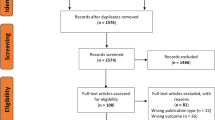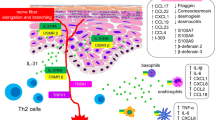Summary
Background
Psoriasis is an autoimmune disease caused by overactivation of TH1 (Type 1 helper cells) and TH17 (T helper 17) cells. Overactivation of TH1 cells inhibits the activity of TH2 cells involved in type 1 allergies, therefore, psoriasis patients might be less affected by type 1 allergies. This study tested if allergies were less frequent in patients with moderate to severe than with mild psoriasis.
Methods
Psoriasis patients at the study site reported possible allergy symptoms and were tested for common allergens by skin prick test and IgE levels. Psoriasis was classified by PASI scores (Psoriasis Area and Severity Index) as mild (PASI <10) or moderate/severe (PASI ≥10). Patients without systemic therapy were assessed separately. Fisher’s exact test was used to test for differences.
Results
A total of 97 patients were included, 21 with mild and 76 with moderate to severe psoriasis. Allergies were found in 27.8%, most commonly against dust mites (23.4%) and grasses (18.1%). Allergies were found in 23.8% of the patients with mild vs. 29.0% allergic patients with moderate to severe psoriasis (P = 0.786). In patients without systemic medication, allergies were found in 21.1% vs. 35.3% (P = 0.463).
Conclusion
Allergy prevalence was not reduced in patients with moderate/severe psoriasis, and generally close to the prevalence in the general Austrian population (24%). The inhibiting effect of psoriasis on type 1 allergies was not confirmed.
Similar content being viewed by others
References
Cited Literature
Patel AB, Tsilioni I, Weng Z, Theoharides TC. TNF stimulates IL‑6, CXCL8 and VEGF secretion from human keratinocytes via activation of mTOR, inhibited by tetramethoxyluteolin. Exp Dermatol. 2018;27:135–43. https://doi.org/10.1111/exd.13461.
Mansouri Y, Goldenberg G. Biologic safety in psoriasis: review of long-term safety data. J Clin Aesthet Dermatol. 2015;8:30–42.
Blumenthal-Barby E. Charakterisierung einer humanen endogenen retroviralen dUTPase als Suszeptibilitätsgen für Psoriasis vulgaris: [Characterization of a human endogenous retroviral dUTPase as susceptibility gene for psoriasis vulgaris] [PhD Thesis]. Berlin: Universitätsmedizin Berlin; 2012.
Nair RP, Stuart PE, Nistor I, Hiremagalore R, Chia NVC, Jenisch S, et al. Sequence and haplotype analysis supports HLA‑C as the psoriasis susceptibility 1 gene. Am J Hum Genet. 2006;78:827–51. https://doi.org/10.1086/503821.
Guttman-Yassky E, Krueger JG. Atopic dermatitis and psoriasis: two different immune diseases or one spectrum? Curr Opin Immunol. 2017;48:68–73. https://doi.org/10.1016/j.coi.2017.08.008.
Chiricozzi A, Suárez-Fariñas M, Fuentes-Duculan J, Cueto I, Li K, Tian S, et al. Increased expression of interleukin-17 pathway genes in nonlesional skin of moderate-to-severe psoriasis vulgaris. Br J Dermatol. 2016;174:136–45. https://doi.org/10.1111/bjd.14034.
Kreft S, Kreft M, Resman A, Marko P, Kreft KZ. Computer-aided measurement of psoriatic lesion area in a multicenter clinical trial—comparison to physician’s estimations. J Dermatol Sci. 2006;44:21–7. https://doi.org/10.1016/j.jdermsci.2006.05.006.
Langen U, Schmitz R, Steppuhn H. Häufigkeit allergischer Erkrankungen in Deutschland: Ergebnisse der Studie zur Gesundheit Erwachsener in Deutschland (DEGS1). Bundesgesundheitsblatt Gesundheitsforschung Gesundheitsschutz. 2013;56:698–706. https://doi.org/10.1007/s00103-012-1652-7.
Maucher J. Erster österreichischer Allergiebericht: Einschätzung und Realität unterschiedlich. Osterr Arzteztg. 2006;11:56–7.
Averbeck M, Gebhardt C, Emmrich F, Treudler R, Simon JC. Immunologic principles of allergic disease. J Dtsch Dermatol Ges. 2007;5:1015–28. https://doi.org/10.1111/j.1610-0387.2007.06538.x.
Benn CS, Bendixen M, Krause TG, Olesen AB. Questionable coexistence of T(H)1- and T(H)2-related diseases. J Allergy Clin Immunol. 2002;110:328–9. author reply 329–30.
Graham-Rowe D. Lifestyle: When allergies got west. Nature. 2011;479:S2–S4.
Oriss TB, McCarthy SA, Morel BF, Campana MA, Morel PA. Crossregulation between T helper cell (Th)1 and Th2: Inhibition of Th2 proliferation by IFN-gamma involves interference with IL‑1. J Immunol. 1997;158:3666–72.
Christophers E. Psoriasis—epidemiology and clinical spectrum. Clin Exp Dermatol. 2001;26:314–20.
Hajdarbegovic E, Nijsten T, Westgeest A, Habraken F, Hollestein L, Thio B. Decreased prevalence of atopic features in patients with psoriatic arthritis, but not in psoriasis vulgaris. J Am Acad Dermatol. 2013;68:270–7. https://doi.org/10.1016/j.jaad.2012.07.018.
Mrowietz U, Kragballe K, Reich K, Spuls P, Griffiths CE, Nast A, et al. Definition of treatment goals for moderate to severe psoriasis: A European consensus. Arch Dermatol Res. 2011;303:1–10.
Ruëff F, Bergmann K‑C, Brockow K, Fuchs T, Grübl A, Jung K, et al. Hauttests zur Diagnostik von allergischen Soforttypreaktionen: Leitlinie der Deutschen Gesellschaft für Allergologie und klinischen Immunologie (DGAKI). Pneumologie. 2011;65:484–95.
Bernstein IL, Li JT, Bernstein DI, Hamilton R, Spector SL, Tan R, et al. Allergy diagnostic testing: An updated practice parameter. Ann Allergy Asthma Immunol. 2008;100:S1–S148.
Kleine-Tebbe J, Ballmer-Weber B, Beyer K, Erdmann S, Fuchs T, Henzgen M, et al. In-vitro-Diagnostik und molekulare Grundlagen von IgE-vermittelten Nahrungsmittelallergien: Leitlinie der Deutschen Gesellschaft für Allergologie und klinische Immunologie (DGAKI), des Ärzteverbandes Deutscher Allergologen (ÄDA), der Gesellschaft für Pädiatrische Allergologie und Umweltmedizin (GPA), der Österreichischen Gesellschaft für Allergologie und Immunologie (ÖGAI) und der Schweizerischen Gesellschaft für Allergologie und Immunologie (SGAI). Allergo J. 2009;18:132–46.
Griebler R, Winkler P, Gaiswinkler S, Delcour J, Jusaszovich B, Nowotny M, et al. Österreichischer Gesundheitsbericht 2016 [Austrian health report 2016]. 2017. Berichtszeitraum 2005–2014/15.
Dittmar D, Uter W, Bauer A, Fortina AB, Bircher AJ, Czarnecka-Operacz M, et al. European Surveillance System on Contact Allergies (ESSCA): polysensitization, 2009–2014. Contact Derm. 2018;78:373–85. https://doi.org/10.1111/cod.12966.
Österreichische Gesellschaft für Pneumologie.. Klimawandel verstärkt Risiko für Allergien und Asthma: Klimawandel und die Folgen für die Lungengesundheit – Ergebnisse aus der LEAD-Studie. Wien: ÖGP; 2017.
Asher MI, Montefort S, Björkstén B, Lai CKW, Strachan DP, Weiland SK, et al. Worldwide time trends in the prevalence of symptoms of asthma, allergic rhinoconjunctivitis, and eczema in childhood: ISAAC Phases One and Three repeat multicountry cross-sectional surveys. Lancet. 2006;368:733–43. https://doi.org/10.1016/S0140-6736(06)69283-0.
Schernhammer ES, Vutuc C, Waldhör T, Haidinger G. Time trends of the prevalence of asthma and allergic disease in Austrian children. Pediatr Allergy Immunol. 2008;19:125–31. https://doi.org/10.1111/j.1399-3038.2007.00597.x.
Bjerg A, Sandström T, Lundbäck B, Rönmark E. Time trends in asthma and wheeze in Swedish children 1996–2006: prevalence and risk factors by sex. Allergy. 2010;65:48–55. https://doi.org/10.1111/j.1398-9995.2009.02105.x.
Zöllner IK, Weiland SK, Piechotowski I, Gabrio T, von Mutius E, Link B, et al. No increase in the prevalence of asthma, allergies, and atopic sensitisation among children in Germany: 1992-2001. Thorax. 2005;60:545–8. https://doi.org/10.1136/thx.2004.029561.
Pigatto PD. Atopy and contact sensitization in psoriasis. Acta Derm Venereol Suppl (Stockh). 2000;80:19–20.
Chen C, Zheng X, Duan Q, Yang P, Zheng Y. High serum IgE concentration in patients with psoriasis. Clin Res Dermatol. 2017;4:1–4.
Skaaby T, Husemoen LLN, Thuesen BH, Fenger RV, Linneberg A. Specific IgE positivity against inhalant allergens and development of autoimmune disease. Autoimmunity. 2015;48:282–8. https://doi.org/10.3109/08916934.2014.1003640.
Rabin RL, Levinson AI. The nexus between atopic disease and autoimmunity: a review of the epidemiological and mechanistic literature. Clin Exp Immunol. 2008;153:19–30. https://doi.org/10.1111/j.1365-2249.2008.03679.x.
Yan K‑X, Huang Q, Fang X, Zhang Z‑H, Han L, Gadaldi K, et al. IgE and FcεRI are highly expressed on innate cells in psoriasis. Br J Dermatol. 2016;175:122–33. https://doi.org/10.1111/bjd.14459.
Gruber S, Tiringer K, Dehlink E, Eiwegger T, Mayer E, Konstantin H, et al. Allergic sensitization in kidney-transplanted patients prevails under tacrolimus treatment. Clin Exp Allergy. 2011;41:1125–32. https://doi.org/10.1111/j.1365-2222.2011.03761.x.
Ozdemir O. New developments in transplant-acquired allergies. World J Transplant. 2013;3:30–5. https://doi.org/10.5500/wjt.v3.i3.30.
Bandelier C, Leimgruber A, Wassenberg J, Bart PA, Spertini F. Allergies alimentaires rares. Rev Med Suisse. 2008;4:1024–9.
Wassenberg J, Bart PA. Modern nutrition and development of new allergies. Rev Med Suisse. 2007;3:1032–7.
Schernhammer ES, Vutuc C, Waldhör T, Haidinger G. Time trends of the prevalence of asthma and allergic disease in Austrian children. Pediatric Allergy and Immunology. 2008;19(2):125–131
de Vos G, Nazari R, Ferastraoaru D, Parikh P, Geliebter R, Pichardo Y, et al. Discordance between aeroallergen specific serum IgE and skin testing in children younger than 4 years. Ann Allergy Asthma Immunol. 2013;110:438–43. https://doi.org/10.1016/j.anai.2013.03.006.
Bergmann K‑C. Current status of allergy prevalence in Germany: Position paper of the Environmental Medicine Commission of the Robert Koch Institute. 2016.
Essl A. Vergleich der Prävalenz von IGE-vermittelten Sensibilisierungen und Allergien bei Patienten mit leichter (PASO 〈 10) und schwerer (PASI 〉 10) Psoriasis vulgaris: [Comparison of the prevalence of IgE mediated sensibilisation and allergy in patients with mild (PASI 〈 10) and severe (PASI 〉 10) psoriasis vulgaris] [Thesis]. Vienna: Medical University Vienna; 2018.
Further Reading
Eyerich S, Onken AT, Weidinger S, Franke A, Nasorri F, Pennino D, et al. Mutual antagonism of T cells causing psoriasis and atopic eczema. N Engl J Med. 2011;365:231–8. https://doi.org/10.1056/NEJMoa1104200.
Acknowledgements
These results were first presented as A. Essl’s thesis [39], supervised by D. Loader and P. Sator. Writing assistance was provided by W. Adlassnig (CW Research and Management GmbH).
Author information
Authors and Affiliations
Corresponding author
Ethics declarations
Conflict of interest
A. Essl, D. Loader, R. Feldmann, A. Steiner, and P. Sator declare that they have no competing interests.
Additional information
Publisher’s Note
Springer Nature remains neutral with regard to jurisdictional claims in published maps and institutional affiliations.
Rights and permissions
About this article
Cite this article
Essl, A., Loader, D., Feldmann, R. et al. Psoriasis and IgE-mediated allergy: correlation or mutual inhibition?. Wien Klin Wochenschr 133, 997–1003 (2021). https://doi.org/10.1007/s00508-020-01683-0
Received:
Accepted:
Published:
Issue Date:
DOI: https://doi.org/10.1007/s00508-020-01683-0




